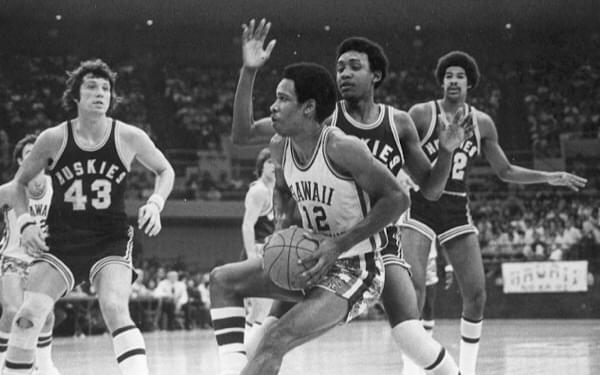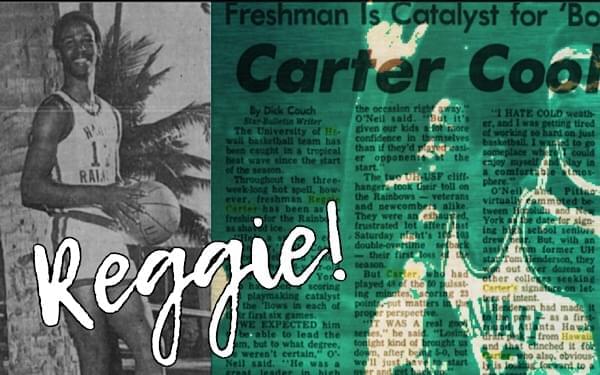By Lance Tominaga, ESPN Honolulu Web Editor.
He was a Rainbow Warrior for only one season, but Reggie Carter is still remembered as one of the greatest University of Hawaii basketball players of all time.
Forty-five years ago, Carter set foot on the Manoa campus with big dreams and expectations. The slender 6-3 point guard out of Brookville, New York was perhaps the biggest recruit in the history of the program. Carter was lured to the Islands by a young UH assistant coach named Rick Pitino.
Al Menendez, a New York native who was then a UH assistant, was overjoyed by Carter’s arrival. “The first time I saw Reggie play was at an eighth-grade all-star game,” Menendez recalled to the Honolulu Advertiser. “Even then you knew he was going to be a special kind of ball player. In 20 years of watching high school basketball on Long Island, Reggie is without a doubt the best high school player I’ve ever seen, and that includes Julius Erving.” (Note: Menendez would later go on to serve as an assistant coach and scout in the NBA.)
Norm Sloan, then the head coach at North Carolina State, told the Honolulu Advertiser that he was stunned to hear that Carter chose Hawaii.
“He’s one of the finest all-around prep players in the nation,” said Sloan. “The way I heard it, the competition among all the school’s boiled down to Maryland, North Carolina and Hawaii. We weren’t in the running. So all the super-recruiters from these three schools were there, gathered together in one room with Carter. There was long and loud conversation as they extolled the virtues of attending their schools. The haggling was still going on when Pitino and Carter suddenly stood up, broke into big smiles, put their arms around each other and walked out the door.”
Carter would later admit that the success that All-American guard Tom Henderson had in Hawaii – he would be a 1974 first-round draft pick by the Atlanta Hawks – played a role in his decision. “I don’t think I would have gone to a school that hadn’t produced any pro ball players,” he told the Honolulu Star-Bulletin.

The short-lived Reggie Carter era got off to a rousing start. Paired with sharpshooting guard Henry Hollingsworth in the backcourt and working with an imposing front line that included veterans Tommy Barker, Melton Werts and fellow freshman George Lett, Carter sparked Hawaii to an 80-66 upset win over Oregon in the 1975-76 season opener. Carter led the Rainbow Warriors with 17 points and 9 rebounds in his collegiate debut. The Ducks had featured All-American guard Ron Lee and future NBA head coach Stu Jackson.
Two weeks later, the ’Bows hosted the No. 12-ranked San Francisco Dons in a battle of the unbeatens. In a wild and highly entertaining contest, Hawaii pulled out an 81-80 victory in front of 7,574 fans at the Honolulu International Center (now the Blaisdell Center). Hollingsworth and Barker led the way with 24 and 23 points respectively, and Carter contributed 15 points and a school record 19 assists. San Francisco was led by freshman center Bill Cartwright, the future NBA All-Star who would go on to win three championship rings with the Chicago Bulls.
The Dons prevailed in the following night’s rematch, but USF head coach Bob Gaillard tipped his hat to the home team. “I can’t say enough about Hawaii, and especially Reggie Carter,” he said. “He can do it all.”
Hawaii head coach Bruce ONeil was similarly impressed. “We expected him to be able to lead the team, but to what degree, we weren’t certain,” said O’Neil. “He was a great leader in high school – the best in the nation. But there’s a big difference between Long Island Lutheran [High School] and major college basketball.”

Carter continued his sterling play in the Rainbow Classic. In the tournament’s opening night win over Yale, Carter recorded Hawaii’s first official triple-double: 12 points, 11 rebounds and 12 assists.
And then the season collapsed.
After beginning the season 7-2, Hawaii lost nine straight games. They would finish a disappointing 9-18 – the program’s first losing season since the 1969-70 campaign.
The team had played under the cloud of an NCAA investigation that stemmed from O’Neil allowing KGMB to use four of his players – Hollingsworth, Gary Gray, Dave Knight and George Ritter – to film a television commercial for Cutter Ford. The four players were suspended and then, without the NCAA’s approval, reinstated by the university. Subsequent investigations uncovered numerous violations involving recruiting and improper benefits. O’Neil was fired on Feb. 6, and Pitino would follow him out the door at the end os the season.
The scandal and resulting two-year NCAA probation would cause long-term damage to the program. At the time, however, the most pressing question on the minds of Hawaii basketball fans was: Will Reggie Carter return for his sophomore season?
The answer, it turned out, was no.
”It wasn’t a spur of the moment thing,” Carter told the Star-Bulletin. “I looked at things carefully, but certain things helped me to decide. No one reason was the factor, though. The confusion and NCAA investigation were among the factors. Most of the time, all I heard was something passed from one guy to another about what was going to happen or what might happen. It was always ‘NCAA this’ or ‘NCAA that.’ All I wanted was something first hand.
”I don’t have any regrets about going to Hawaii last year and I’ll tell my friends to go there. The coaches kept all their promises to me and I was very happy until all that stuff started happening. Then it became scary.”
in Carter’s one season at UH, he led the team in scoring (16.6 points per game) and assists. His 199 assists was a single-season record until Anthony Carter broke it in 1998.
Carter returned to New York and joined Lou Carnesecca’s storied St. John’s program. After sitting out a year as a transfer, he had three solid seasons for the then-Redmen, averaging 14.5 points a contest. He exploded for 39 points in a game against BYU. Most impressive of all, in the 1979 NCAA Tournament, Carter led St. John’s to within one game of making a Final Four appearance.
The New York Knicks selected Carter in the second round of the 1979 NBA Draft. He played two seasons for the Knicks, averaging 3.5 points per game.
Carter later became an assistant principal at Mineola High School in New York. Sadly, he passed away on Christmas Eve 1999 of a rare Tuberculosis-like illness. He was 42.
# # #


